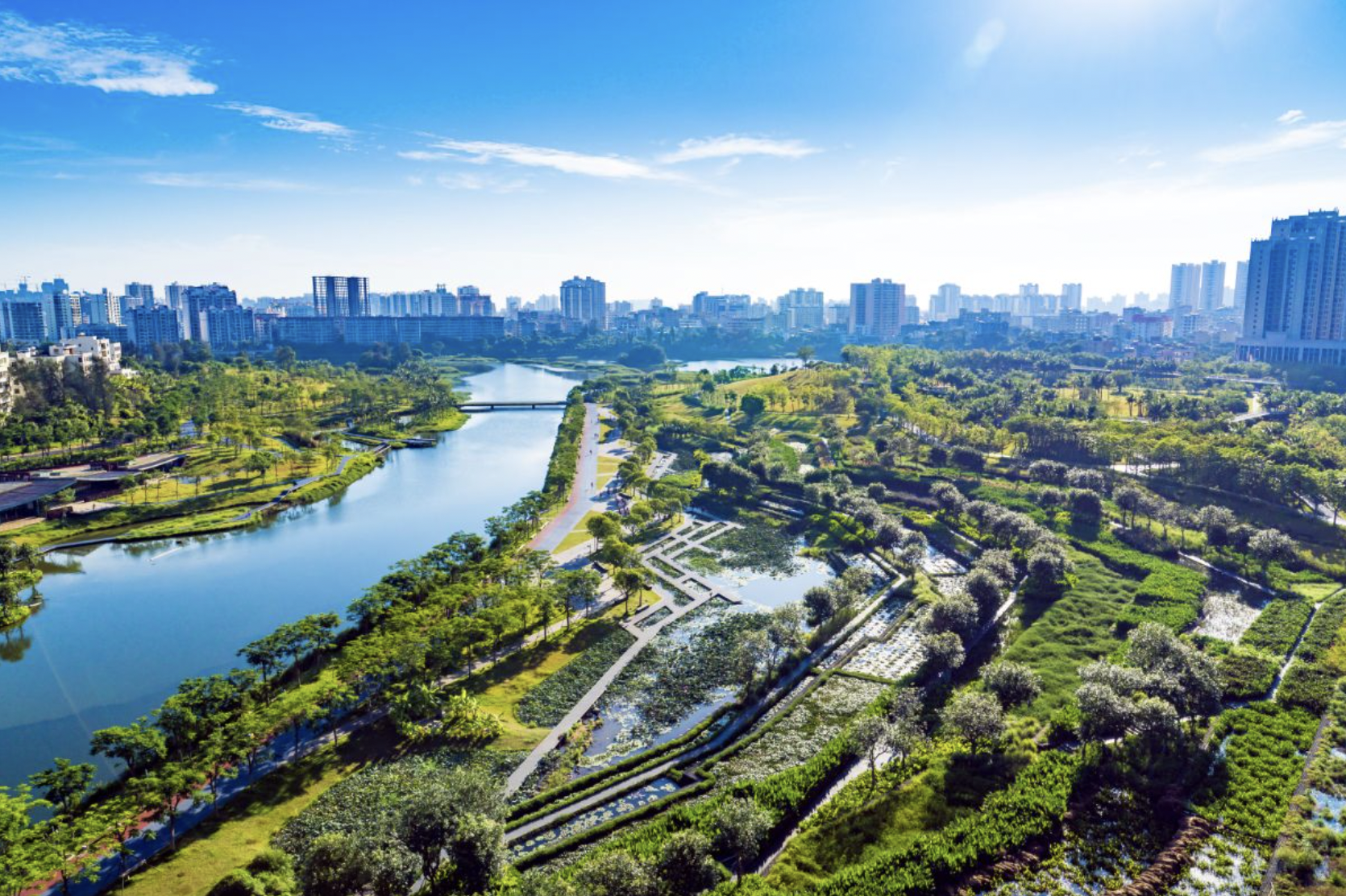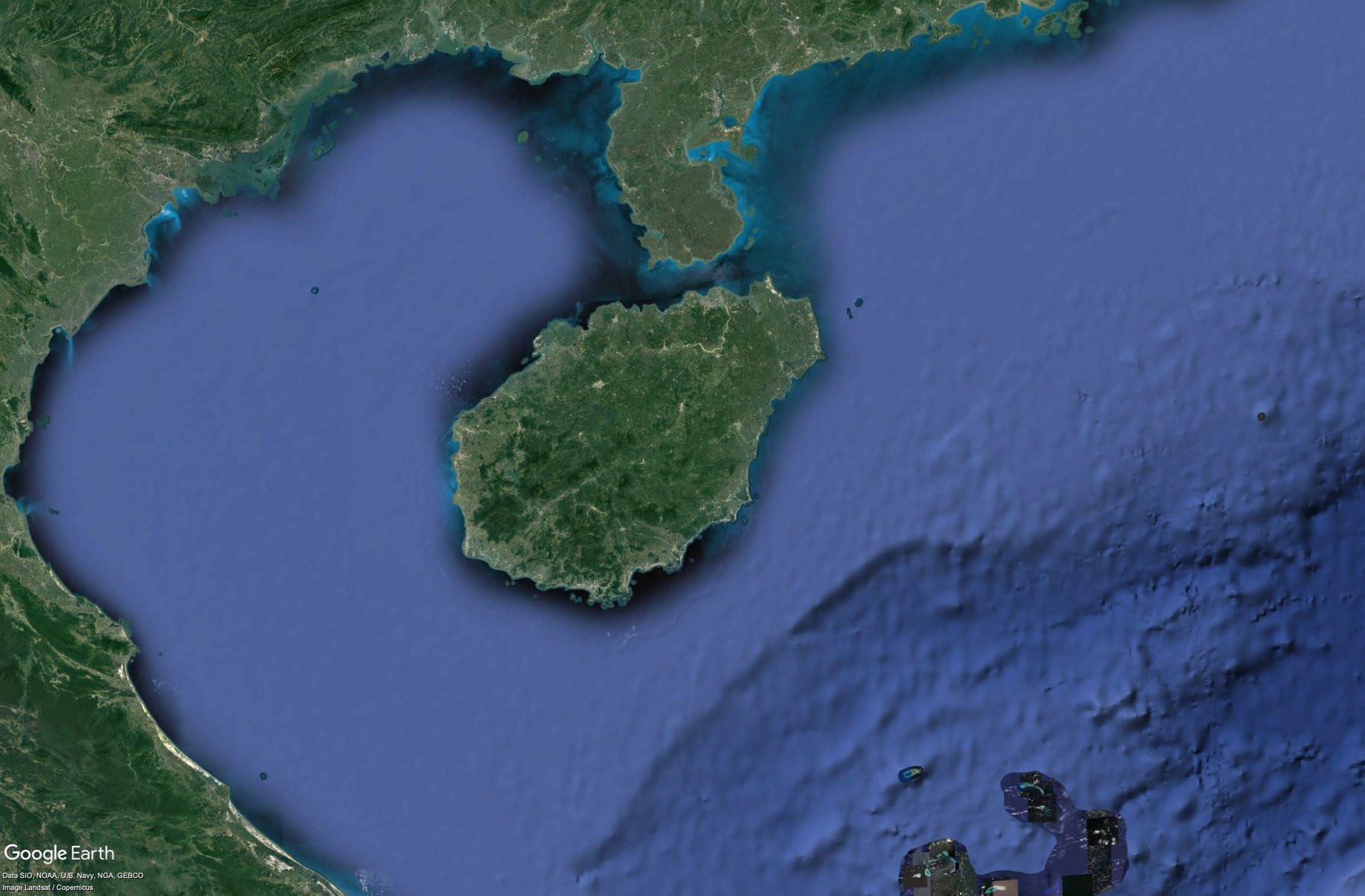From an airplane window, Hainan, an oval-shaped island floating alone in the expanse of the South China Sea, resembles a sea sponge.
In reality, the Chinese province genuinely is a kind of engineered urban sponge, thanks to its pioneering network of green, nature-based infrastructure capable of absorbing storm floods and soaking up heavy monsoon rains.
“If you want to survive, you have to be spongy,” says Yu Kongjian, dean of Peking University’s College of Architecture and Landscape Architecture, and founder of Turenscape, one of China’s largest landscape architecture firms. “Trying to protect cities with hard, gray infrastructure made of concrete is doomed to fail.”
Over the years, many architects, engineers and city planners have espoused the value of, and need for, effective water management in urban areas. But Kongjian was the first to propose the holistic concept of the “sponge city.”

The idea is not to install enormous artificial foam structures across urban areas, but rather to create cities filled with natural spaces such as parks, lakes and wetlands — which are capable of absorbing, storing and cleaning rain and floods — as well as smaller tools like bioswales, rain gardens, permeable pavements and green roofs. Such “green and blue infrastructure” is in contrast with the manmade “gray infrastructure” that fills most cities — think concrete walls and hard flood barriers, which cause water to build up on surfaces and limit collection of valuable groundwater for drinking, irrigation and more.
While good water management has always been essential for cities, climate change, which is bringing more extreme rains and floods and causing sea level rise — combined with urban growth into more vulnerable areas — has made it an even bigger priority.
“One of the problems all cities are facing is that as they are growing, they are simply cementing over all the land,” says Asit K. Biswas, an expert in water management and distinguished visiting professor at the University of Glasgow. “So the water that used to percolate to the ground doesn’t anymore. Flooding becomes an issue, and important groundwater isn’t replenished. That is why we need sponge cities.”
This emerging approach to urban water management also soaks up all kinds of other benefits: green, nature-based spaces provide habitat for wildlife and areas for exercise and relaxation (which can boost the physical and mental health of residents), as well as likely increasing the value of surrounding property and the city more widely.
Kongjian’s “sponge city” idea is inspired by the ancient Chinese agricultural approach to water management. For centuries, rural farmers have carved out rice terraces across China’s southwest region and beyond, using basic “cut and fill” methods to cultivate mountainous terrain with water-filled paddies. In Kongjian’s hometown, there were seven water ponds, which helped manage monsoons. Many other civilizations around the world, he adds, also have monsoon- and flood-adapted ways of life.
“This is not just primitive agriculture by valley-dwelling peasants,” he says. “It is a cultural heritage that is built on 5,000 years of water management experience.”
Kongjian’s theory dates back as far as 2003, when he observed that “natural wetlands along rivers can function like sponges to retain water during flooding and recharge water during drought.” But it was a decade later, in the aftermath of floods in the capital Beijing that killed 79 people, that China launched the Sponge City Program with pilots across 16 cities (14 more have been added since). By 2030, China’s sponge cities aim to process 70 percent of rainwater across 80 percent of their land.
Hainan, which frequently suffers from severe floods due to its monsoon climate coupled with the worsening effects of global warming, was picked as one of the project’s leading demonstration sites.

In 2015, the local government and the national Ministry of Housing and Urban and Rural Construction kickstarted efforts to transform the island’s two major cities, Haikou and Sanya. Kongjian and his team began by giving presentations on the “Sponge City” concept and ecological restoration — these were mandatory for officials — and developing a mass public information campaign to gain community support. Crucially, a “water-based ecological infrastructure plan” identified at-risk areas and how to protect them with wetlands, rice paddies, parks and coastal habitats.
In Haikou, which is home to the 23-kilometer-long Meishe River, the concrete flood walls were removed, and the surrounding area was turned into a mangrove restoration project with floodable pedestrian paths running through it. In addition, terraced wetlands were added to help process 6,000 tons of treated wastewater per day, improving the water quality from grade V (the poorest surface water quality) to grade III (non-potable water clean enough to swim in). Similarly, in Sanya, an “interlocking finger design” of waterways was constructed to buffer the force of ocean tides hitting the coast. Green terraces were added, staggered from the 9-meter-high street level down to sea level, with channels known as bioswales used to capture stormwater runoff.
“Inundation has virtually stopped,” says Kongjian.
Other efforts to turn Chinese cities into sponges have also proven effective. A study of Wuhan found its 389 sponge city projects across 38.5 square kilometers have not only reduced flooding, but sequestered 725 tons of CO2 a year, reduced temperatures by more than 3°C (5°F) and more than doubled the value of the land.

Adoption of the sponge city model is increasing globally, too. More than 100 “rain gardens” have been built in the Welsh city of Cardiff, which soak up 40,000 square meters of rainwater each year, lessening the burden on the sewer network. Philadelphia’s $4.5 billion Green City, Clean Waters plan, which will run until 2036, is already keeping 2.7 billion gallons of stormwater runoff and sewer overflow out of local waterways. The Orbital Forest of Tirana in Albania will see the city surrounded by a ring of two million trees, which will clean the air, limit urban sprawl and provide flood protection. In the Dutch city of Rotterdam, blue-green roofs have reduced water treatment costs by $75,000 annually and prevented roughly 10,000 tons of CO2 emissions.
Meanwhile, although the Global South is disproportionately suffering the effects of extreme weather, studies show there is an opportunity for cities worldwide to grow sustainably through nature-based infrastructure. A study by design firm Arup found that it is 50 percent more affordable than man-made alternatives, and 28 percent more effective.
Yet there are limits to what a sponge city can withstand. Research published in The Royal Society scientific journal found that while sponge cities should be able to process 1-in-30-year rainfall events, 19 of the 30 pilot cities in China have experienced flooding since 2014. Some 14 million people were impacted by floods in the city of Zhengzhou in 2021. Nearly 400 people died or went missing.
“Sponge cities can maybe deal with sea level rise of one or two meters, but five meters? No,” admits Kongjian. “But if the sponge city can’t stop it, nothing can. You have to move the city away.”
Crushed by negative news?
Sign up for the Reasons to be Cheerful newsletter.Part of the problem, according to Faith Chan, head of the School of Geographical Sciences at University of Nottingham Ningbo China, is that the current sponge city efforts are not genuinely citywide.
“Currently it’s too focused on small-scale green space development to solve the water problem in the ideas of construction,” he says. “The projects shouldn’t just focus on a district or set of apartments. It has to be connected with larger areas.”
Lack of land availability, the need for political support and significant financial cost are also barriers, according to Biswas, who has carried out work in China since the 1980s. “It’s true that retrofitting or reconstructing cities is expensive,” he says. “And while new sponge cities are cheaper, most of the world lives in old cities.”
But Kongjian, whose firm has carried out over 1,000 projects across 200 cities, says that the sponge city model is improving day by day as the evidence base grows. He calls the recent spongification of Bangkok’s Benjakitti Forest Park a “great success” that has already stood up to city flooding.
“This is not something luxury; you have to do it,” he says. “Resiliency is key.”









